Introduction
The Trident II (D5) Strategic Launch Ballistic Missile (SLBM) is the primary strategic seaborne deterrent of the United States, launched from Ohio-class submarines, the largest in the U.S. Navy. Each submarine hosts twenty-four D5 missiles, which are three-stage, solid-propellant, and inertially guided.
The D5 improves upon its predecessor, the Trident I C4, with enhanced range, yield, and accuracy, comparable to land-based ICBMs, and has a reach of over 4,000 nautical miles. It boasts a payload twice that of Trident I, with dimensions of 44 feet in length and 83 inches in width.
The D5 can be equipped with Mark 4 or Mark 5 reentry bodies, carrying multiple nuclear warheads. The Mark 4 utilizes the W-76 warhead, whereas the Mark 5 employs the W-88, the most potent warhead in the U.S. arsenal.
About this Timeline
The Trident II D5s journey began in October 1983 when the U.S. Navy initiated a three-year development program for the Trident II. This culminated in its first flight test in January 1987. By March 1990, the Trident II was operational and deployed aboard the USS Tennessee (SSBN 734).
This comprehensive chronology details the development and operational history of the Trident II D5 since the 1980s. The text is adapted from the “FBM Facts/chronology: Polaris, Poseidon, Trident,” published by the U.S. Navy’s Strategic Systems Program Office.
1980s
1981
2 OCTOBER 1981
- The Secretary of Defense (SecDef) directed the U.S. Navy to fund an advanced development program for a TRIDENT II (D5) missile with a late 1989 Initial Operational Capability (IOC).
1982
28 APRIL 1982
- The Vice Chief of Naval Operations provided the Chief of Naval Material with an updated statement of the TRIDENT II (D5) Weapon System Program Objectives. Among other things, specific objectives were to maintain the survivability of the submarine and add prompt hard-target kill capability. The TRIDENT II objectives were to be reviewed and revised as information became available during the Advanced Development Phase of the TRIDENT II program.
1 JUNE 1982
- The Secretary of the Navy (SecNav) advised the Chairman of the House of Representatives and Senate Committees on Armed Services (HAS/SASC) and Appropriations (HAC/SAC) of his decision not to accelerate the development of the TRIDENT II (D5) missile, but to rephase introduction of the missile the D5 system into TRIDENT submarines from the keel up, commencing with the ninth TRIDENT hull. Previously, the plan had been to introduce the TRIDENT II (D5) system by backfitting the 13th TRIDENT hull.
1983
20 JULY 1983
- Lockheed Missiles and Space Company, Inc., selected United Technologies Corporation’s Chemical Systems Division as the subcontractor for full-scale engineering development and initial production of the TRIDENT II third-stage rocket motor.
12 SEPTEMBER 1983
- The Assistant Secretary of the Navy for Research, Engineering, and Systems (R&E&S) forwarded the approved Navy TRIDENT II Test and Evaluation Master Plan to the Under Secretary of Defense of Research and Engineering.
1 OCTOBER 1983
- The Strategic Systems Project Office began full-scale engineering development of the TRIDENT II (D5) Strategic Weapon System. Development commenced following 3 years of advanced development and a review for readiness to proceed into engineering development by the Defense Systems Acquisition Review Council on 26 September 1983.
28 OCTOBER 1983
- For the initial phase of the TRIDENT II (D5) development program, the Strategic Systems Project Office executed letter contracts with Westinghouse Electric Corporation for the launcher, with General Electric Ordnance Systems for fire control, with Interstate Electronics Corporation for test instrumentation, and with Lockheed Missiles and Space Company, Inc., for the missile.
These letter contracts and a contract with Sperry Systems Management for navigation would be defined as Operational Systems Development and Production (OSDP) contracts. A letter of contract was also executed for the guidance subsystem development but not for the OSDP form of contracting because, although developed by Charles Stark Draper Laboratory, the guidance system is produced by other contractors.
21 NOVEMBER 1983
- The Navy awarded a contract for the 11th TRIDENT submarine (SSBN 736) to the Electric Boat Division of General Dynamics, Groton, CT.
1986
14 MARCH 1986
- The construction contract for SSBN 738, the 13th TRIDENT SSBN, was awarded by the Navy to the Electric Boat Division of General Dynamics, Groton, CT.
9 JUNE 1986
- SSBN 734, the first TRIDENT II submarine, was assigned the name TENNESSEE by The Secretary of the Navy (SecNav). She would be the sixth U.S. Naval ship named Tennessee honoring the 16th state.
26 NOVEMBER 1986
- D5 Skycatch testing commenced at the Hunters Point Launch Test Facility.
13 DECEMBER 1986

- The first TRIDENT II (D5) submarine, USS TENNESSEE (SSBN 734), was launched during ceremonies at the Electric Boat Division of General Dynamics, Groton, CT. Mrs. Landess Kelso, wife of Admiral Frank B. Kelso, Commander, of the U.S. Atlantic Fleet, was the ship’s sponsor.
23 DECEMBER 1986
- The Director of the Strategic Systems Program (DIRSSP) reached an agreement and signed a contract with Unisys (Sperry) for the FY 87 add-on to the TRIDENT II (D5) contracts.
1987
15 JANUARY 1987
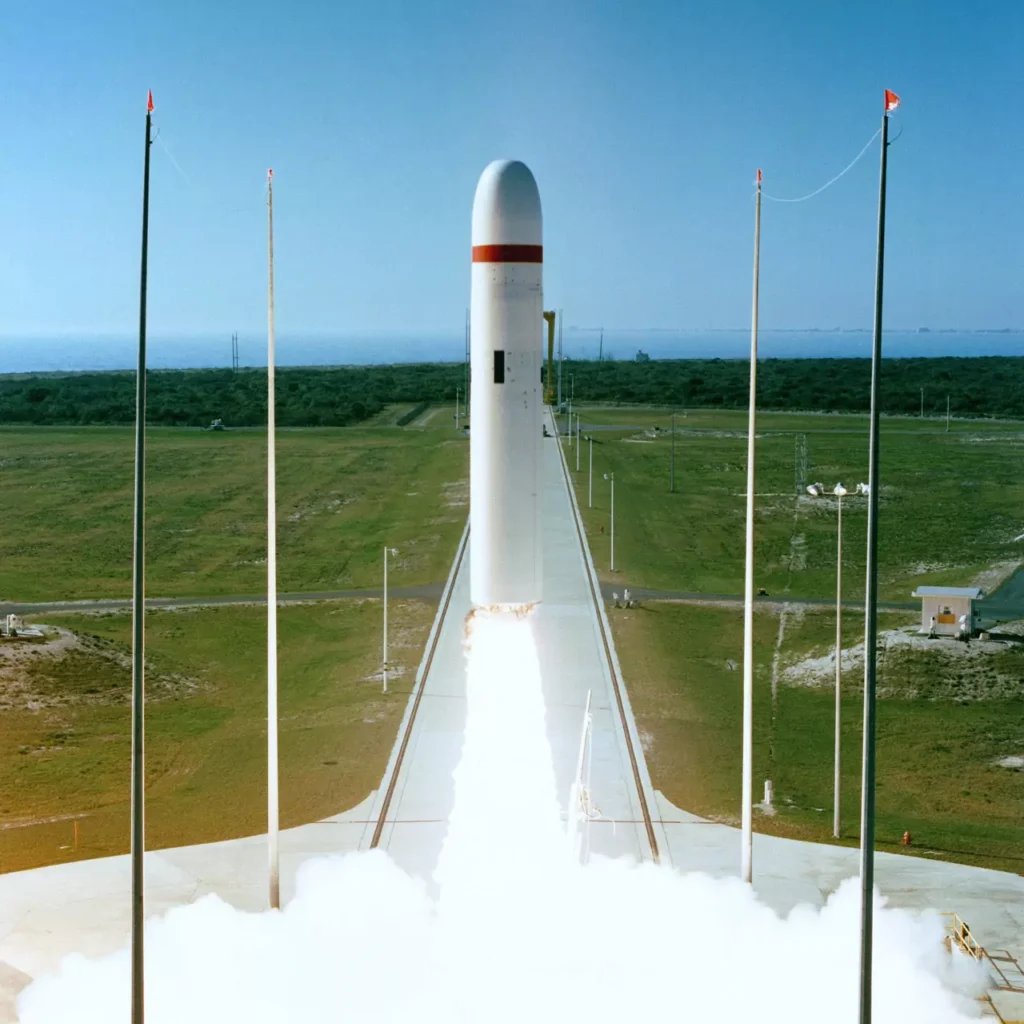
- The Navy’s first flight test in the TRIDENT II (D5) development program (DSX-1) was successfully conducted from Launch Complex 46A at Cape Canaveral, FL.
2 MARCH 1987
- The Secretary of the Navy (SecNav) announced that SSBN 735, the second D5 submarine, would be named PENNSYLVANIA honoring the Second, Thirteen Original States of the Union. SSBN 735 would be the fourth U.S. ship to carry the name.
17 MARCH 1987
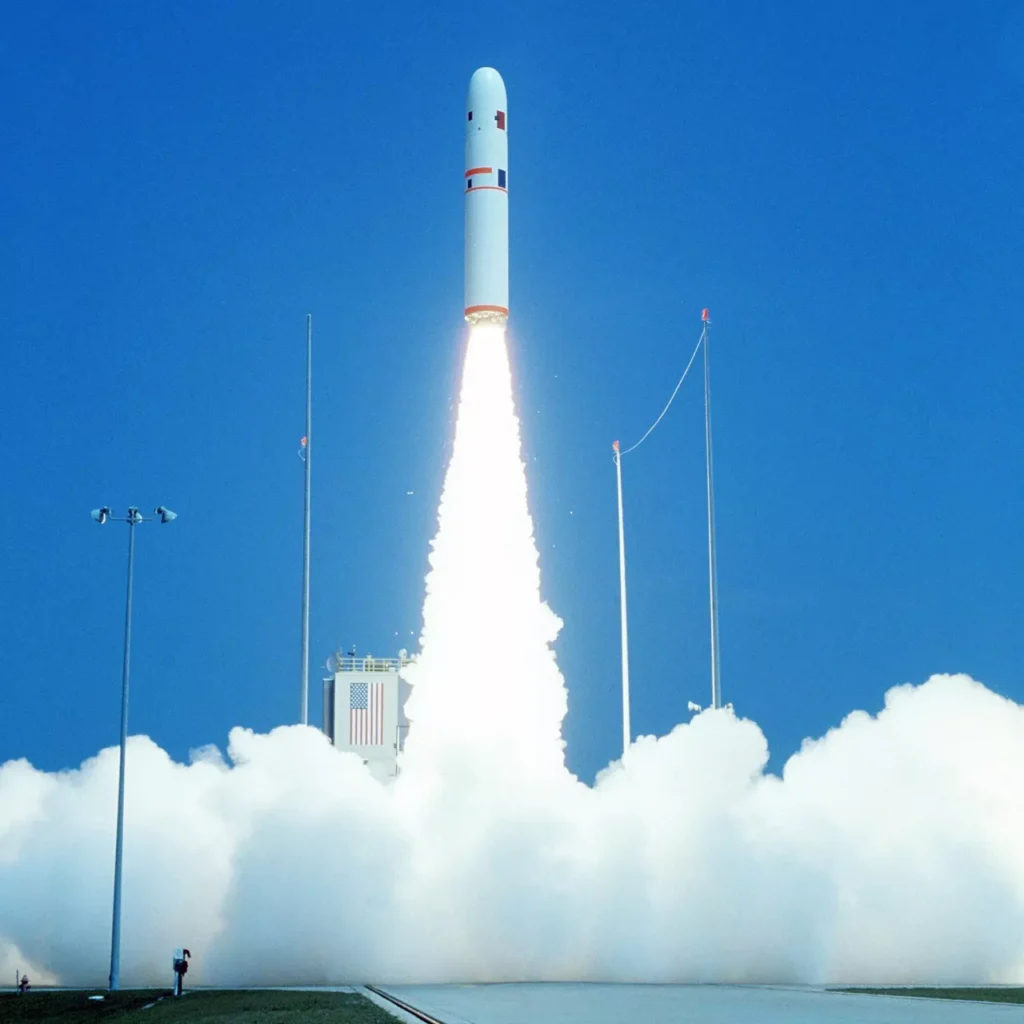
- The second flight test in the TRIDENT II (D5) development program (D5X-2) was successfully conducted from Launch Complex 46A at Cape Canaveral, FL.
30 APRIL 1987
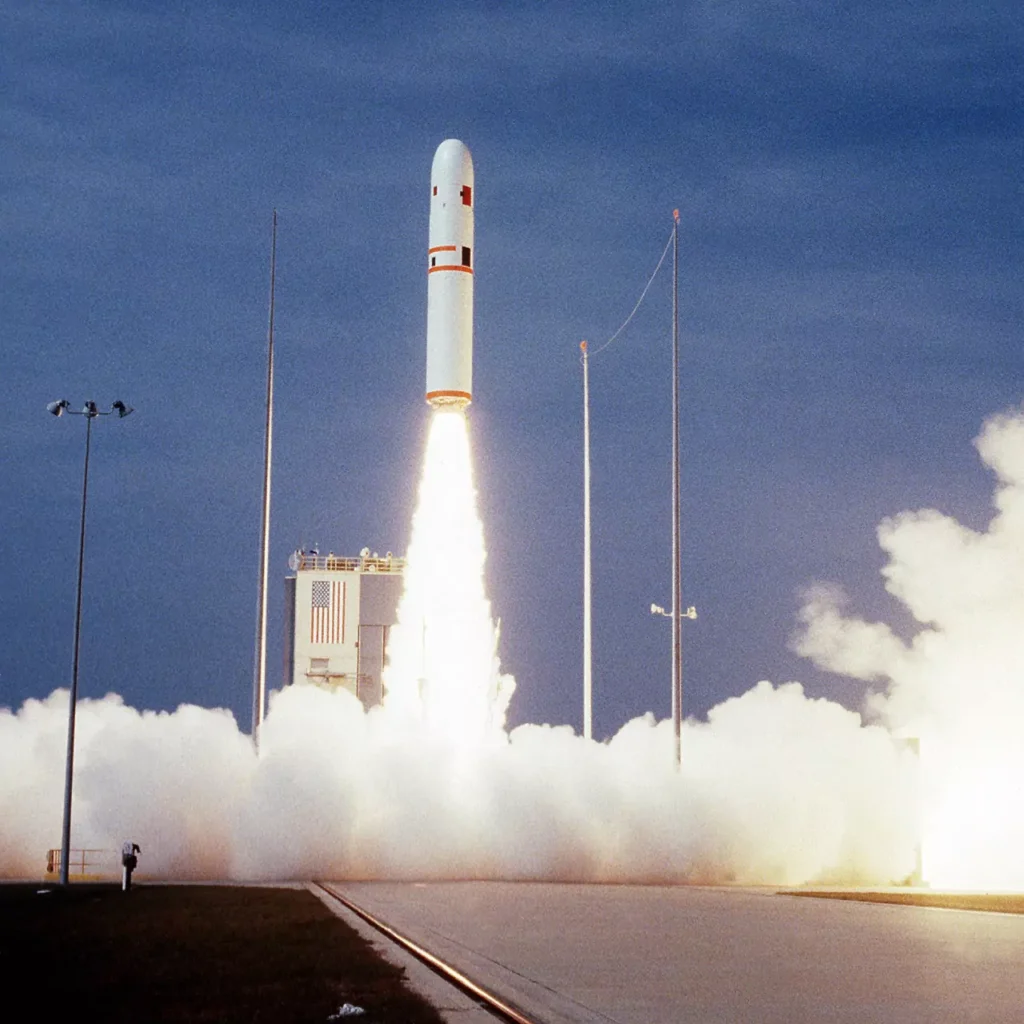
- The Navy’s third flight test in the TRIDENT II (D5) development program (D5X-3) was successfully conducted from Launch Complex 46A at Cape Canaveral, FL.
26 MAY 1987
- A $615 million construction contract for SSBN 739, the 14th TRIDENT submarine, was awarded to the Electric Boat Division of General Dynamics, Groton, CT, with a follow-on option to build SSBN 740.
12 JUNE 1987

- The Navy’s fourth flight test in the TRIDENT II (D5) development program (D5X-5) was successfully conducted from Launch Complex 46A at Cape Canaveral, FL.
20 JULY 1987
- The Navy’s fifth flight test in the TRIDENT II (D5) development program (D5X-6) was successfully conducted from Launch Complex 46A at Cape Canaveral, FL.
8 SEPTEMBER 1987
- The Navy’s sixth flight test in the TRIDENT II (D5) development program (D5X-4) was successfully conducted from Launch Complex 46A at Cape Canaveral, FL.
6 OCTOBER 1987
- The Navy’s seventh flight test in the TRIDENT II (D5) development program (D5X-8) was conducted from Launch Complex 46A at Cape Canaveral, FL. This flight test was considered only a partial success because several reentry bodies failed to deploy due to an interlock problem.
1 DECEMBER 1987
- The Under Secretary of the Navy approved the continued production of TRIDENT II (D5) missiles for FY 88 and FY 89.
11 DECEMBER 1987

- The Navy’s eighth flight test in the TRIDENT II (D5) development program (D5X-10) was successfully conducted from Launch Complex 46A at Cape Canaveral, FL.
18 DECEMBER 1987
- SSBN 736, the third TRIDENT II submarine, was assigned the name WEST VIRGINIA by SecNav. She honors the 35th State of the Union. Only two previous U.S. Navy ships had been named West Virginia.
- SSBN 737, the fourth TRIDENT II submarine, was assigned the name KENTUCKY by SecNav. She honors the 15th State of the Union. Only one previous U.S. Navy ship had been named Kentucky, Battleship No. 6, commissioned in 1900.
- SSBN 738, the fifth TRIDENT II submarine, was assigned the name MARYLAND by SecNav. She honors the seventh of the Thirteen Original States of the Union. Three previous ships had been named Maryland.
- SSBN 739, the sixth TRIDENT II submarine, was assigned the name NEBRASKA by SecNav. She honors the 37th State of the Union. Only one previous U.S. Navy ship had been named Nebraska, Battleship No. 14, commissioned in 1907, which took part in the round-the-world voyage of the “Great White Fleet” and escorted troop convoys during World War I.
1988
5 JANUARY 1988
- The Navy awarded a contract to the Electric Boat Division of General Dynamics, Groton, CT, for the construction of SSBN 740, the seventh TRIDENT II submarine, with options for 741 and 742 in FY 89 and FY 90, respectively.
21 JANUARY 1988
- The Navy’s ninth flight test in the TRIDENT II (D5) development program (D5X-9) was conducted from Launch Complex 46A at Cape Canaveral, FL. This flight test was unsuccessful because of a flight control electronics package problem during the third-stage flight.
28 MARCH 1988
- The House Armed Services Committee praised the Navy for its management of the TRIDENT II submarine missile program.
7 APRIL 1988
- The Navy’s 10th flight test in the TRIDENT II (D5) development program (D5X-11) was successfully conducted from Launch Complex 46A at Cape Canaveral, FL.
21 APRIL 1988
- The Navy’s 11th flight test in the TRIDENT II (D5) development program (D5X-12) was successfully conducted from Launch Complex 46A at Cape Canaveral, FL.
23 APRIL 1988
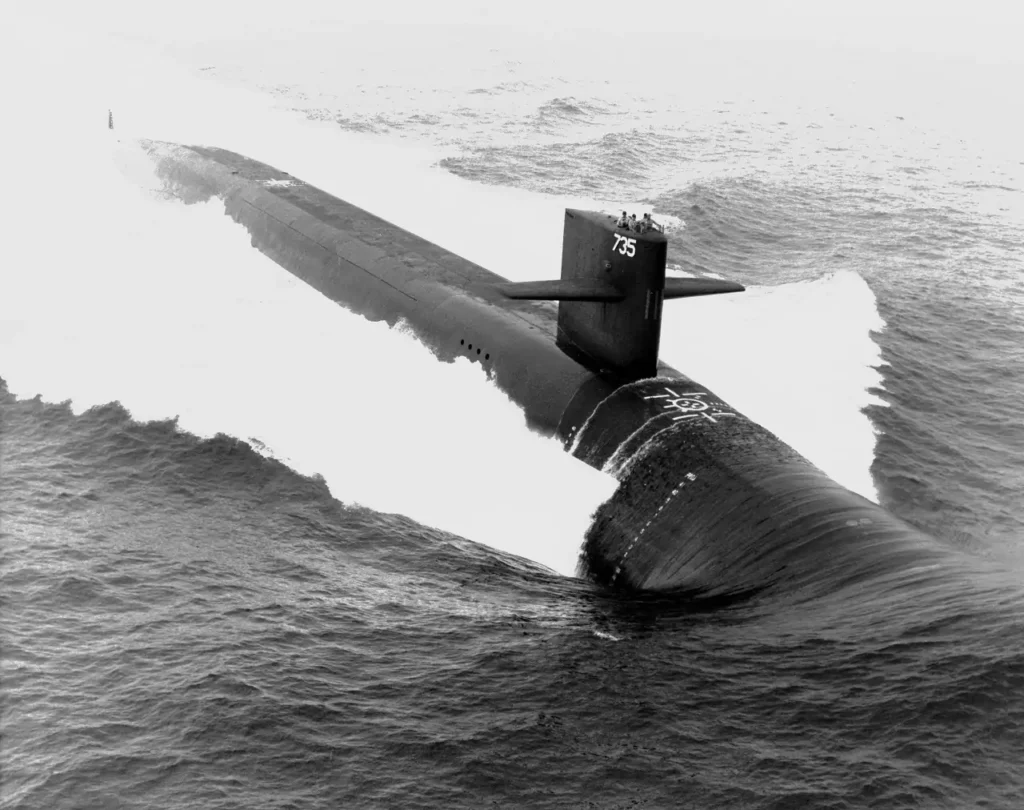
- USS PENNSYLVANIA (SSBN 735), the second TRIDENT II submarine, was launched during ceremonies at the Electric Boat Division of General Dynamics, Groton, CT. Mrs. Marilyn K. Garrett, wife of the Honorable H. Lawrence Garrett III, Under Secretary of the Navy, was the ship’s sponsor.
25 MAY 1988
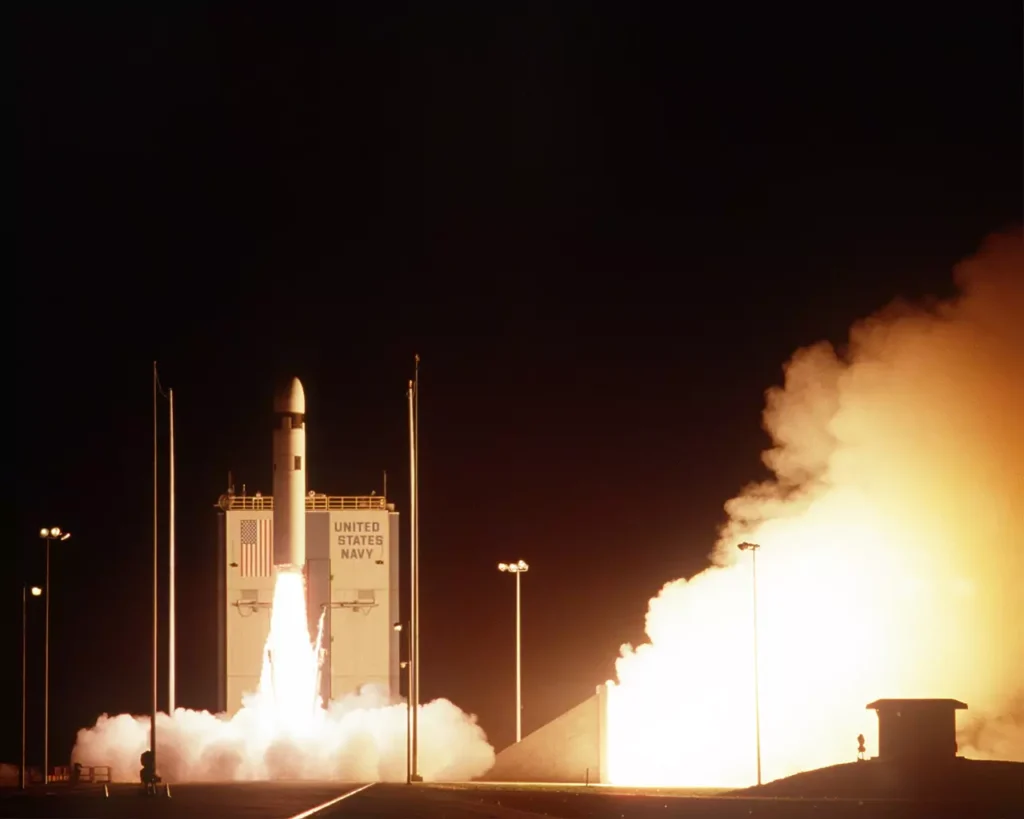
- The Navy’s 12th flight test in the TRIDENT II (D5) development program (D5X-7) was successfully conducted from Launch Complex 46A at Cape Canaveral, FL.
7 JULY 1988
- The Navy’s 13th flight test in the TRIDENT II (D5) development program (D5X-13) was conducted from Launch Complex 46A at Cape Canaveral, FL. This flight test was unsuccessful because of a thrust vector control problem during the first-stage flight.
27 AUGUST 1988
- The Navy’s 14th flight test in the TRIDENT II (D5) development program (D5X-14) was successfully launched from Launch Complex 46A at Cape Canaveral, FL.
19 SEPTEMBER 1988
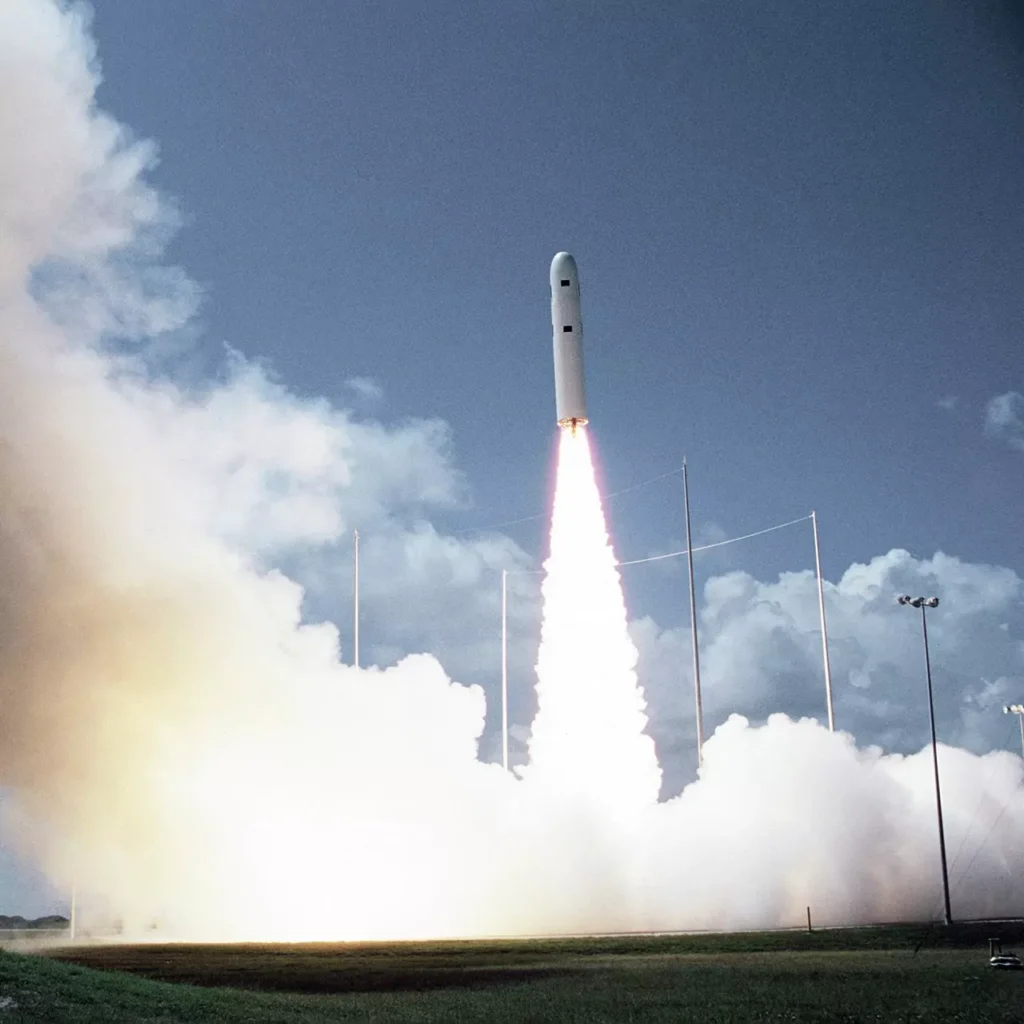
- The Navy’s 15th flight test in the TRIDENT II (D5) development program (D5X-15) was conducted from Launch Complex 46A at Cape Canaveral, FL. The missile was destroyed during the first-stage flight. Post-flight analysis revealed that the missile was on an acceptable flight path at the time it was destroyed. The flight was classified as a “No Test.”
4 OCTOBER 1988
- A 72-month, $617.4 million construction contract for SSBN 741, the eighth TRIDENT II SSBN, was awarded to the Electric Boat Division of General Dynamics, Groton, CT. Contract completion was scheduled for October 1994.
11 OCTOBER 1988
- The Electric Boat strike ended. Electric Boat Division of General Dynamics reported that SSBNs 734, 735, 740, and 741 contract delivery dates would not be affected. Delays would be experienced on the delivery of SSBNs 736 through 739.
7 NOVEMBER 1988
- The Navy’s 16th flight test in the TRIDENT II (D5) development program (D5X-18) was successfully conducted from Launch Complex 46A at Cape Canaveral, FL.
18 NOVEMBER 1988
- USS TENNESSEE (SSBN 734), the ninth TRIDENT submarine, was delivered 43 days ahead of schedule and below the target cost to the Navy by the shipbuilder, Electric Boat Division of General Dynamics, Groton, CT.
16 DECEMBER 1988
- The Navy’s 17th flight test in the TRIDENT II (D5) development program (D5X-17) was successfully conducted from Launch Complex 46A at Cape Canaveral, FL.
17 DECEMBER 1988
- USS TENNESSEE (SSBN 734), the ninth TRIDENT submarine, was commissioned during ceremonies at the Electric Boat Division of General Dynamics, Groton, CT. The principal speaker for the event was former Senator Howard H. Baker of Tennessee. The commissioning officer was Vice Admiral Roger Bacon, COMSUBLANT.
1989
9 JANUARY 1989
- The Navy’s 18th flight test in the Trident II (D5) development program (D5X-19) was successfully conducted from Launch Complex 46A at Cape Canaveral, FL.
15 JANUARY 1989

- USS TENNESSEE (SSBN 734), the first submarine to carry the TRIDENT II (D5) missile, arrived at her home port of Kings Bay, GA. USS TENNESSEE’s ceremonial arrival marked the beginning of TRIDENT operations in the Atlantic fleet.
26 JANUARY 1989
- The Navy’s 19th flight test in the TRIDENT II (D5) development program (D5X-20) was successfully conducted from Launch Complex 46A at Cape Canaveral, FL. D5X-20’s successful flight concluded the TRIDENT II pad shots, opening the way for the submerged D5 firings which would begin with the PEM-1 being launched in March 1989 from USS TENNESSEE (SSBN 734).
21 MARCH 1989

- The Navy’s first TRIDENT II (D5) Performance Evaluation Missile (PEM-1) was launched from USS TENNESSEE (SSBN 734) off the coast of Cape Canaveral, FL. As a result of the failure of this flight test, several modifications were made to strengthen and protect the first-stage nozzle. This PEM fix program caused TRIDENT II’s Initial Operational Capability to slip from 31 December 1989 to 23 March 1990.
29 MARCH 1989
- An explosion occurred in the propellant Mix 2 building at the Hercules, Inc., Bacchus West Facility, Magna, UT. There were no personnel injuries and no damage was sustained to the TRIDENT II (D5) propellant mix operation in the Mix 1 building.
2 AUGUST 1989
- The Navy’s second TRIDENT II (D5) Performance Evaluation Missile was successfully launched from USS TENNESSEE (SSBN 734).
15 AUGUST 1989
- The Navy’s third TRIDENT II (D5) Performance Evaluation Missile was launched from USS TENNESSEE (SSBN 734). This flight was unsuccessful because of higher-than-expected water pressures on the first-stage nozzle (like the first PEM) and demonstrated that additional fixes were necessary.
22 AUGUST 1989
- USS PENNSYLVANIA (SSBN 735), the 10th TRIDENT submarine, was delivered to the Navy by the shipbuilder, Electric Boat Division of General Dynamics, Groton, CT.
9 SEPTEMBER 1989
- USS PENNSYLVANIA (SSBN 735) was commissioned during ceremonies at New London, CT. She joins USS TENNESSEE (SSBN 734) as the second TRIDENT ship to be home-ported at Kings Bay, GA. The principal speaker for the event was the Honorable H. Lawrence Garrett III, Secretary of the Navy.
18 OCTOBER 1989
- A contract to build SSBN 742, the 17th TRIDENT submarine, was signed with the Electric Boat Division of General Dynamics, Groton, CT. It was the third ship in an authorization that included SSBN 740 in FY 88 and SSBN 741 in FY 89.
26 OCTOBER 1989
- USS TENNESSEE (SSBN 734) completed a Post Shakedown Availability at the Electric Boat Division of General Dynamics, Groton, CT.
4 DECEMBER 1989
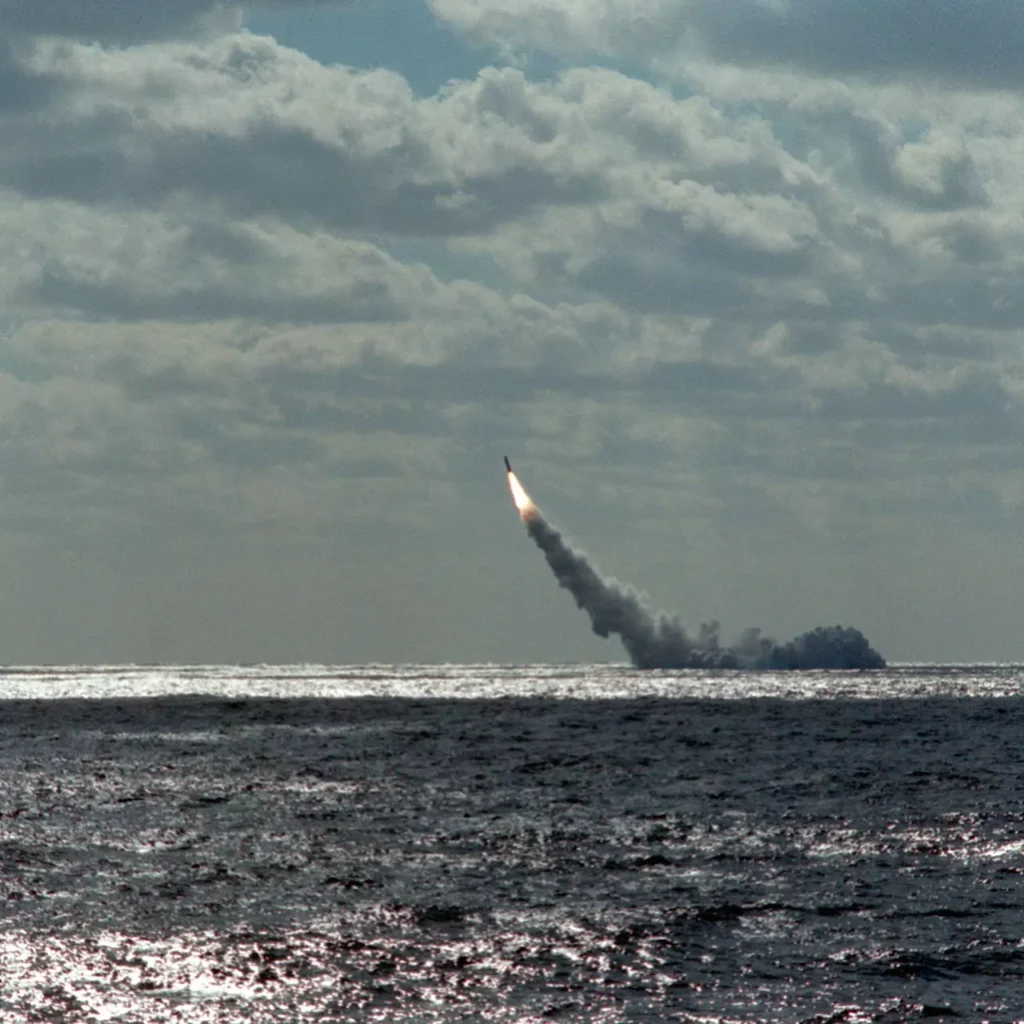
- The Navy’s fourth TRIDENT II (D5) Performance Evaluation Missile was successfully launched from USS TENNESSEE (SSBN 734). This missile incorporated all fixes necessary to preclude the failures seen in PEM flights 1 and 3.
13 DECEMBER 1989
- The Navy’s fifth TRIDENT II (D5) Performance Evaluation Missile was successfully launched from USS TENNESSEE (SSBN 734).
15 DECEMBER 1989
- The Navy’s sixth TRIDENT II (D5) Performance Evaluation Missile was successfully launched from USS TENNESSEE (SSBN 734).
1990s
1990
8 JANUARY 1990
- The Director and staff of Strategic Systems Programs were congratulated by the CNO for their outstanding efforts on the occasion of the third consecutive successful TRIDENT II (D5) missile launch. The extraordinary engineering and management expertise demonstrated by the missile team and the timely effort to modify the system were recognized as admirable technical achievements.
15 JANUARY 1990
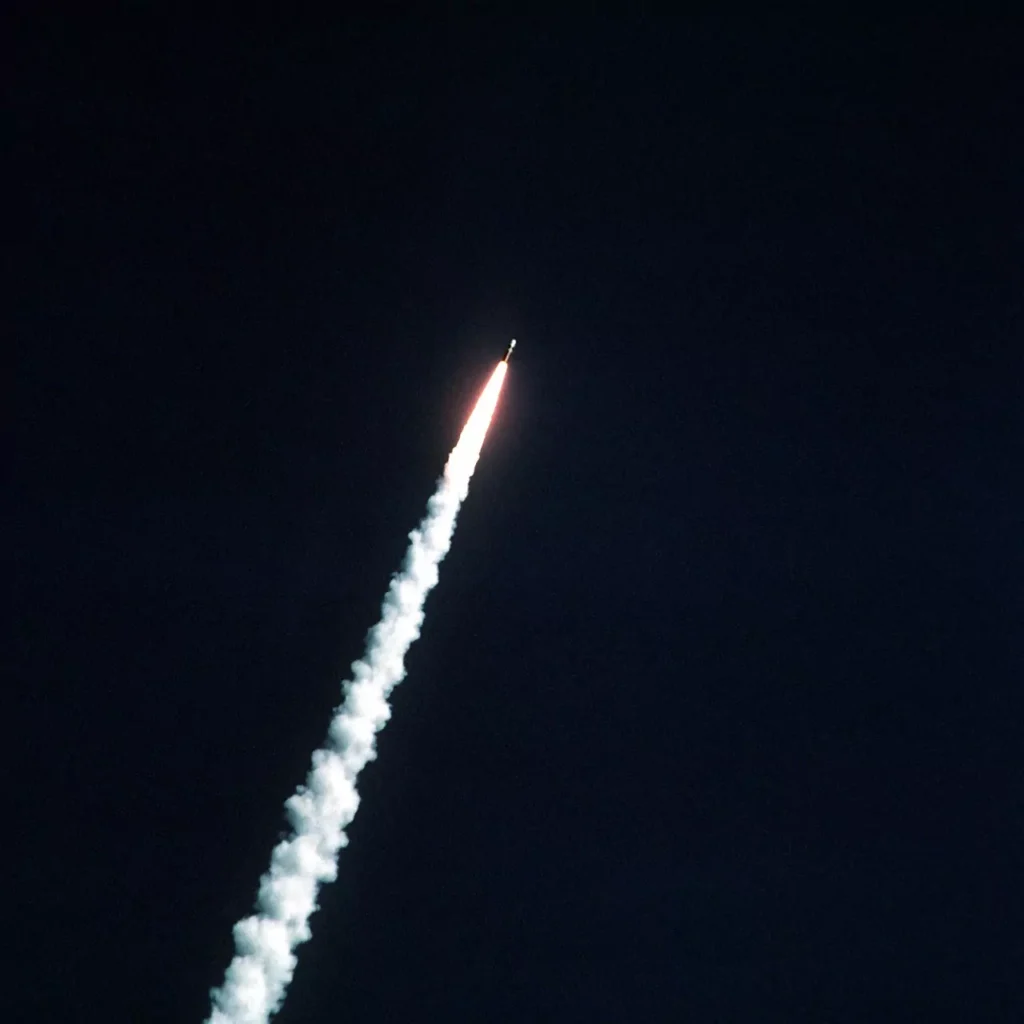
- The seventh TRIDENT II (D5) Performance Evaluation Missile was successfully launched by the Blue Crew of the USS TENNESSEE (SSBN 734) off Cape Canaveral, FL.
16 JANUARY 1990
- The eighth TRIDENT II (D5) Performance Evaluation Missile was successfully launched by the Blue Crew of the USS TENNESSEE (SSBN 734) off Cape Canaveral, FL.
19 JANUARY 1990
- The supervision of the Navy’s newest TRIDENT Submarine Base at Kings Bay, GA, was transferred from its builder, Strategic Systems Programs (SSP), to the Commander in Chief, U.S. Atlantic Fleet, and Commander, Submarine Force, U.S. Atlantic Fleet. This significant event marked the culmination of a long development effort by SSP.
The base at Kings Bay is an integral part of the Nation’s strategic modernization program, supporting the operation of TRIDENT submarines carrying the new TRIDENT II (D5) missile. The facility, which will sustain deploying TRIDENT submarines, has a complement of over 31,000 personnel and includes first-class facilities such as a new exchange, commissary, and recreation facilities. Advanced all-weather missile handling and fabrication complexes and refit maintenance facilities were constructed to maximize the TRIDENT SLBM’s at-sea readiness. Kings Bay facilities also include the Navy’s largest single schoolhouse – the TRIDENT Training Facility.
29 JANUARY 1990
- The Director, Strategic Systems Programs, certified the TRIDENT II (D5) Strategic Weapon System ready for Operational Test Phase II and commenced the start of Demonstration and Shakedown Operation on the USS TENNESSEE (SSBN 734).
12 FEBRUARY 1990
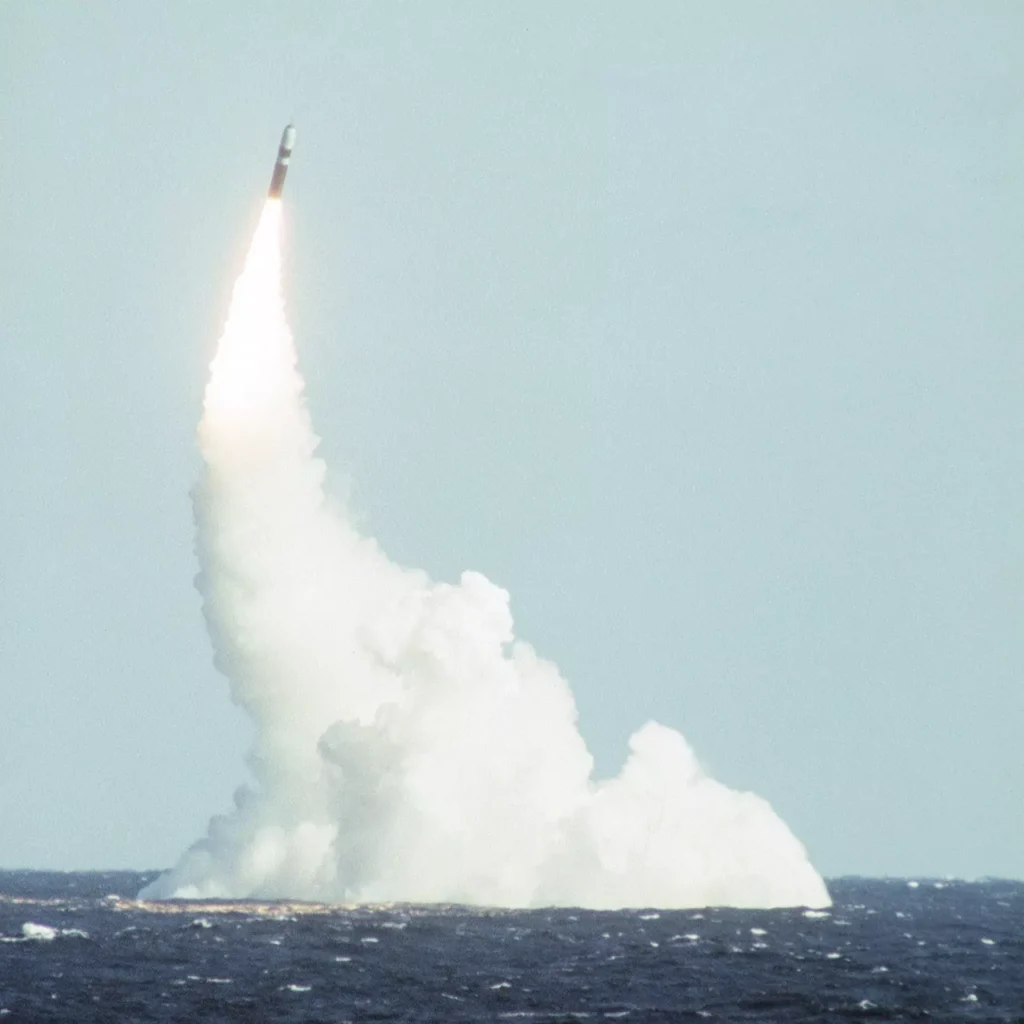
- USS TENNESSEE (SSBN 734) Blue Crew successfully launched the first TRIDENT II (D5) missile of a two-missile ripple launch during a Demonstration and Shakedown Operation (DASO-01) off Cape Canaveral, FL. This was the ninth TRIDENT II submarine-launched missile. The second half of the two-missile launch was the 10th TRIDENT II submarine-launched missile and the last Performance Evaluation Missile launched.
11 MARCH 1990
- USS PENNSYLVANIA (SSBN 735) Gold Crew successfully launched a TRIDENT II (D5) missile during a Demonstration and Shakedown Operation off Cape Canaveral, FL.
23 MARCH 1990
- The Strategic Weapons Facility, Atlantic, Kings Bay, GA, completed the offloading of 24 tactical TRIDENT II (D5) missiles on board USS TENNESSEE (SSBN 734). The loadout and acceptance of the missiles by USS TENNESSEE signaled the achievement of Initial Operational Capability for the TRIDENT II Program. Reaching this key milestone completed a full-scale development program lasting over 6 years.
- The TRIDENT II Development Program met all performance requirements and was completed under the original budget estimate set at the beginning of the program. The TRIDENT II represented the sixth generation missile of the Navy’s Fleet Ballistic Missile Program. USS TENNESSEE began the first TRIDENT II (D5) patrol on 29 March 1990.
30 MARCH 1990
- The TRIDENT I (C4) and TRIDENT II (D5) test nomenclature changed from Operational Test (OT) and Follow-on Operational Test (FOT) to CINC Evaluation Test (CET) and Follow-on CINC Evaluation Test (FCET). The term “Operational Test” now refers to the operational test and evaluation of a weapon system before approval for full acquisition.
FEBRUARY 1990
- D5 development was completed with seven consecutive launch successes:
| Launch date | Type |
|---|---|
| 12/4/89 | PEM |
| 12/13/89 | PEM |
| 12/15/89 | PEM |
| 1/5/90 | PEM |
| 1/16/90 | PEM |
| 2/12/90 | PEM |
| 2/12/90 | DASO |
MARCH 1990
- USS TENNESSEE (SSBN 734) deployed with D5 missiles (D5 IOC).
14 MAY 1990
- The Secretary of the Navy, Honorable H. Lawrence Garrett II, presented the Navy Unit Commendation to the Strategic Systems Programs for exceptionally meritorious service in prosecuting the TRIDENT II (D5) development program from 1 November 1979 to 31 March 1990. The award was presented to Rear Admiral Kenneth C. Malley, Naval Chief of Naval Operations, during ceremonies held at the Crystal Gateway Marriott, Arlington, VA.
11 AUGUST 1990
- USS KENTUCKY (SSBN 737), the fourth TRIDENT II (D5) submarine, was launched during ceremonies at the Electric Boat Division of General Dynamics, Groton, CT.
11 SEPTEMBER 1990
- A Department of Defense Strategic Systems Committee review of the TRIDENT II (D5) program was held to assess SSP’s readiness for full-rate production. It concluded that a formal DAB review was not required and recommended to the Under Secretary of Defense, Acquisition, that the TRIDENT II (D5) Program continue with full-rate production.
22 SEPTEMBER 1990
- USS WEST VIRGINIA (SSBN 736) completed new construction at the Electric Boat Division of General Dynamics, Groton, CT. This was the third TRIDENT II submarine to be delivered.
26 SEPTEMBER 1990
- USS PENNSYLVANIA (SSBN 735) Blue Crew successfully launched a TRIDENT II (D5) missile during a Demonstration and Shakedown Operation.
13 OCTOBER 1990
- USS PENNSYLVANIA (SSBN 735) completed her strategic loadout at Strategic Weapons Facility, Atlantic, Kings Bay, GA, and deployed. The first patrol began on 26 October 1990.
20 OCTOBER 1990

- USS WEST VIRGINIA (SSBN 736), the third TRIDENT II (D5) submarine, was commissioned during ceremonies at the Electric Boat Division of General Dynamics, Groton, CT. The ship’s sponsor was Mrs. Robert C. Byrd.
3 NOVEMBER 1990
- USS TENNESSEE (SSBN 734) Blue Crew successfully launched a TRIDENT II (D5) missile during the first test on the Eastern CINC Range Evaluation Test (CET) on the Eastern Test Range (ETR) off Cape Canaveral, FL.
28 NOVEMBER 1990
- USS WEST VIRGINIA (SSBN 736) Blue Crew successfully conducted a Demonstration and Shakedown Operation.
19 DECEMBER 1990
- A new construction contract was awarded to build the last TRIDENT II (D5) submarine, SSBN 743. The contract was awarded to the Electric Boat Division of General Dynamics, Groton, CT, with a delivery date of 31 August 1997.
1991
7 JANUARY 1991
- In a letter to the Assistant Secretary of the Navy (Research, Development and Acquisition), the Director, Strategic Systems Programs (Rear Admiral Kenneth C. Malley, USN), stated his intentions to cease all planning and stop all FY 91 contractual actions for the TRIDENT II (D5) Backfit Program. He further stated his intentions to terminate all contracts awarded. These actions were necessary to prevent unnecessary expenditure of funds.
11 JANUARY 1991
- In a letter to the Chief of Naval Operations, the Director, Strategic Systems Programs, requested permission to disestablish the Strategic Systems Programs, Detachment B, at Interstate Electronics Corporation in Anaheim, CA. With the completion of the development of the TRIDENT II weapon system, the scope and magnitude of the test instrumentation program management function performed by Detachment B were greatly reduced. The disestablishment was to become effective by 30 September 1991.
15 APRIL 1991
- The Gold Crew of the USS WEST VIRGINIA (SSBN 736) successfully launched a TRIDENT II (D5) DASO missile on the Eastern Test Range (ETR) off Cape Canaveral, FL. This was the 37th TRIDENT II test missile flown and the 18th missile to be launched from a TRIDENT submarine.
27 JUNE 1991
- USS KENTUCKY (SSBN 737), the fourth TRIDENT II (D5) submarine, was delivered to the Navy by the shipbuilder, Electric Boat Division of General Dynamics, Groton, CT.
13 JULY 1991

- USS KENTUCKY (SSBN 737) was commissioned during ceremonies at the Electric Boat Division of General Dynamics, Groton, CT. She would be home-ported at Kings Bay, GA. The principal speaker for the commissioning was the Honorable Larry J. Hopkins, United States Representative, Commonwealth of Kentucky. The ship’s sponsor was Mrs. Carolyn Pennebaker Hopkins.
29 JULY 1991
- The Blue Crew of USS PENNSYLVANIA (SSBN 735) successfully launched four missiles during a TRIDENT II (D5) CINC Evaluation Test on the Eastern Test Range (ETR) off Cape Canaveral, FL.
10 AUGUST 1991
- USS MARYLAND (SSBN 738), the fifth TRIDENT II (D5) submarine, was launched at the Electric Boat Division of General Dynamics, Groton, CT.
30 AUGUST 1991
- USS KENTUCKY (SSBN 737) Blue Crew successfully launched a TRIDENT II (D5) missile in support of a Demonstration and Shakedown Operation.
29 SEPTEMBER 1991
- USS WEST VIRGINIA (SSBN 736) completed her strategic loadout at Strategic Weapons Facility, Atlantic, Kings Bay, GA, and deployed. The first patrol began on 3 December 1991.
4 NOVEMBER 1991
- USS KENTUCKY (SSBN 737) Gold Crew successfully launched a TRIDENT II (D5) missile in support of its Demonstration and Shakedown Operation off Cape Canaveral, FL.
11 NOVEMBER 1991
- USS PENNSYLVANIA (SSBN 735) Blue Crew successfully launched four TRIDENT II (D5) missiles during a TRIDENT II (D5) CINC Evaluation Test from the Eastern Test Range (ETR) off Cape Canaveral, FL.
1992
21 FEBRUARY 1992
- USS WEST VIRGINIA (SSBN 736) Blue Crew successfully launched four TRIDENT II (D5) missiles during a CINC Evaluation Test.
25 APRIL 1992

- A special ceremony was conducted at the U.S. Submarine Base, Kings Bay, GA, commemorating the 3000th SSBN patrol, completed by the USS TENNESSEE (SSBN 734). Guest speakers at the celebration included General Colin L. Powell, Chairman of the Joint Chiefs of Staff, Admiral Frank B. Kelso II, Chief of Naval Operations, and Vice Admiral Henry G. Chiles, Jr., Commander, Submarine Force, U.S. Atlantic Fleet.
2 JUNE 1992
- USS KENTUCKY (SSBN 737) completed her strategic loadout at Strategic Weapons Facility, Atlantic, Kings Bay, GA, and deployed. The first patrol began on 2 August 1992.
5 JUNE 1992
- USS MARYLAND (SSBN 738), the fifth TRIDENT II (D5) Ohio class submarine, was delivered to the Navy during ceremonies at Electric Boat Division of General Dynamics, Groton, CT. USS MARYLAND honors the seventh state of the Union. She is the first submarine and the third naval vessel to bear the name.
13 JUNE 1992

- USS MARYLAND (SSBN 738), the fifth TRIDENT II (D5) submarine, was commissioned during ceremonies at the Electric Boat Division of General Dynamics, Groton, CT. The ship’s sponsor was Mrs. Sarah C. Larson.
18 JUNE 1992
- USS NEBRASKA (SSBN 739) Blue Crew successfully launched three TRIDENT II (D5) missiles during a CINC Evaluation Test.
29 JULY 1992
- USS MARYLAND (SSBN 738) Blue Crew successfully launched a TRIDENT II (D5) missile during a Demonstration and Shakedown Operation.
4 AUGUST 1992
- USS TENNESSEE (SSBN 734) Blue Crew successfully launched four TRIDENT II (D5) missiles during a CINC Evaluation Test.
15 AUGUST 1992
- USS NEBRASKA (SSBN 739), the sixth TRIDENT II (D5) submarine, was launched during ceremonies at the Electric Boat Division of General Dynamics, Groton, CT.
3 SEPTEMBER 1992
- USS KENTUCKY (SSBN 737) Gold Crew successfully launched four TRIDENT II (D5) missiles during a CINC Evaluation Test.
10 SEPTEMBER 1992
- USS TENNESSEE (SSBN 734) Gold Crew successfully launched four TRIDENT II (D5) missiles during a CINC Evaluation Test.
23 OCTOBER 1992
- SSBN 743, the 10th TRIDENT II submarine, was named LOUISIANA by SecNav.
1993
11 MAY 1993
- Rear Admiral John T. Mitchell, Director of Strategic Systems Programs, testified before the United States Senate Committee on Armed Services Subcommittee on Nuclear Deterrence, Arms Control, and Defense Intelligence. The testimony concerned TRIDENT II missile economic production rates and total inventory objectives.
27 MAY 1993
- USS MARYLAND (SSBN 738) completed her strategic loadout at Strategic Weapons Facility, Atlantic, Kings Bay, GA, and deployed. The first patrol began on 22 June 1993.
18 JUNE 1993
- USS NEBRASKA (SSBN 739), the sixth TRIDENT II (D5) submarine, was delivered to the Navy by the Electric Boat Division of General Dynamics, Groton, CT. USS NEBRASKA was the 14th TRIDENT submarine delivered.
7 JULY 1993
- USS PENNSYLVANIA (SSBN 735) Gold Crew successfully launched two TRIDENT II (D5) missiles during a Follow-on CINC Evaluation Test.
10 JULY 1993

- USS NEBRASKA (SSBN 739) was commissioned during ceremonies at the Naval Undersea Warfare Center, New London, CT. The principal speaker for the event was the Honorable J. James Exon, U.S. Senator, State of Nebraska. The ship’s sponsor was Mrs. Patricia Pros Exon. The commissioning officer was Vice Admiral Henry G. Chiles, Jr., Commander, Submarine Force, U.S. Atlantic Fleet and Commander, Submarines Allied Command, Atlantic. The USS NEBRASKA was the second U.S. naval ship to be named in honor of the 37th state of the Union.
17 JULY 1993
- The RHODE ISLAND (SSBN 740), the 15th TRIDENT submarine, was launched during ceremonies at the Electric Boat Division of General Dynamics, Groton, CT. Mrs. Kati Machtley, wife of the Honorable Ronald K. Machtley, U.S. Representative, State of Rhode Island, was the ship’s sponsor.
20 AUGUST 1993
- USS NEBRASKA (SSBN 739) Blue Crew successfully launched one TRIDENT II (D5) missile during a Demonstration and Shakedown Operation.
18 NOVEMBER 1993

- USS NEBRASKA (SSBN 739) Gold Crew successfully launched one TRIDENT II (D5) missile during a Demonstration and Shakedown Operation. This was the last new construction TRIDENT submarine to conduct two firing DASOs.
1994
20 JANUARY 1994
- USS MARYLAND (SSBN 738) successfully launched four TRIDENT II (D5) missiles during a Follow-on CINC Evaluation Test.
28 MAY 1994
- USS NEBRASKA (SSBN 739) completed her strategic loadout at Strategic Weapons Facility, Atlantic, Kings Bay, GA, and deployed. The first patrol began on 26 June 1994.
22 JUNE 1994
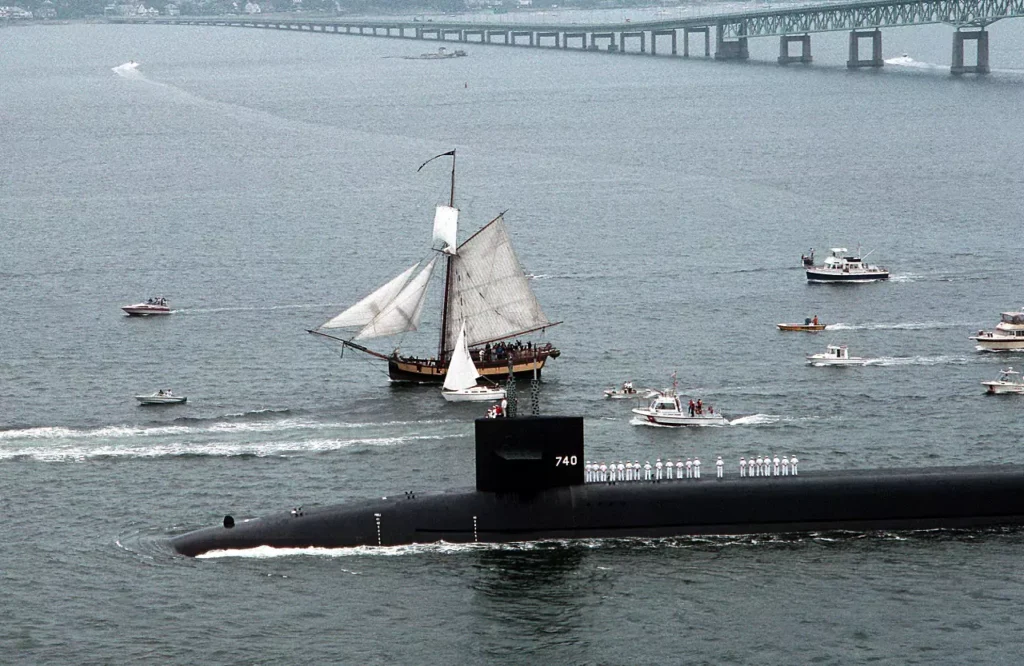
- USS RHODE ISLAND (SSBN 740), the seventh TRIDENT II (D5) submarine, was delivered to the Navy by the Electric Boat Division of General Dynamics, Groton, CT. This was the 15th TRIDENT submarine delivered. The ship was commissioned at Newport, RI, on 9 July 1994. Honoring the 13th state of the Union, RHODE ISLAND is the first submarine and the third naval vessel to bear the name.
16 NOVEMBER 1994
- USS RHODE ISLAND (SSBN 740) Gold Crew successfully launched one TRIDENT II (D5) missile during the ship’s Demonstration and Shakedown Operation.
7 DECEMBER 1994
- USS HENRY M. JACKSON (SSBN 730) successfully launched two TRIDENT II (D5) missiles during a Follow-on CINC Evaluation Test.
1995
19 JANUARY 1995
- USS NEBRASKA (SSBN 739) successfully launched two TRIDENT II (D5) missiles during a Follow-on CINC Evaluation Test.
9 APRIL 1995
- USS TENNESSEE (SSBN 734) successfully launched two TRIDENT II (D5) missiles during a Follow-on CINC Evaluation Test.
19 JUNE 1995
- USS RHODE ISLAND (SSBN 740) completed her strategic loadout at Strategic Weapons Facility, Atlantic, Kings Bay, GA, and deployed. The first patrol began on 3 July 1995.
21 JUNE 1995

- USS MAINE (SSBN 741), the eighth TRIDENT II (D5) submarine, was delivered to the Navy by the Electric Boat Division of General Dynamics, Groton, CT. This was the 16th TRIDENT submarine delivered. The ship was commissioned at Portsmouth Naval Shipyard, Kittery, MA, on 29 July 1995.
15 JULY 1995
- USS WYOMING (SSBN 742), the ninth TRIDENT II (D5) submarine, was christened during ceremonies at the Electric Boat Division of General Dynamics, Groton, CT. The ship’s sponsor was Mrs. Monica Owens, wife of Admiral W. Owens, Vice Chairman, Joint Chiefs of Staff.
7 DECEMBER 1995
- USS MAINE (SSBN 741) Gold Crew successfully launched one TRIDENT II (D5) missile during the ship’s Demonstration and Shakedown Operation.
1996
21 APRIL 1996
- USS MARYLAND (SSBN 738) successfully launched two TRIDENT II (D5) missiles during a Follow-on CINC Evaluation Test.
20 JUNE 1996
- USS WYOMING (SSBN 742), the ninth TRIDENT II (D5) submarine, was delivered to the Navy during ceremonies at the Electric Boat Division of General Dynamics, Groton, CT. This was the 17th TRIDENT submarine delivered.
3 JULY 1996
- USS MAINE (SSBN 741) completed her strategic loadout at Strategic Weapons Facility, Atlantic, Kings Bay, GA, and deployed. The first patrol began on 12 July 1996.
13 JULY 1996

- USS WYOMING (SSBN 742), the ninth TRIDENT II (D5) submarine, was commissioned during ceremonies at the Electric Boat Division of General Dynamics, Groton, CT.
19 JULY 1996
- USS PENNSYLVANIA (SSBN 735) successfully launched two TRIDENT II (D5) missiles during a Follow-on CINC Evaluation Test.
27 JULY 1996
- USS LOUISIANA (SSBN 743), the 10th TRIDENT II (D5) submarine, was christened during ceremonies at the Electric Boat Division of General Dynamics, Groton, CT. The ship’s sponsor was Mrs. Patricia O’Keefe, mother of former Secretary of the Navy.
28 OCTOBER 1996
- USS TENNESSEE (SSBN 734) successfully launched two TRIDENT II (D5) missiles during a Follow-on CINC Evaluation Test.
1997
17 MARCH 1997
- USS WEST VIRGINIA (SSBN 736) successfully launched two TRIDENT II (D5) missiles during a Follow-on CINC Evaluation Test.
30 MAY 1997
- USS WYOMING (SSBN 742) Blue Crew successfully launched one TRIDENT II (D5) missile during the ship’s Demonstration and Shakedown Operation.
4 AUGUST 1997
- USS WYOMING (SSBN 742) completed her strategic loadout at Strategic Weapons Facility, Atlantic, Kings Bay, GA, and deployed. The first patrol began on 19 August 1997.
14 AUGUST 1997
- USS LOUISIANA (SSBN 743), the 10th and final TRIDENT II (D5) submarine, was delivered to the Navy during ceremonies at the Electric Boat Division of General Dynamics, Groton, CT. This was the 18th TRIDENT submarine delivered. The ship was commissioned on 6 September 1997.
6 SEPTEMBER 1997

- USS LOUISIANA (SSBN 743), the 10th TRIDENT II (D5) submarine, was commissioned during ceremonies at the TRIDENT Naval Base at Kings Bay, GA. Like all D5 boats, she was home-ported in Kings Bay, GA.
18 DECEMBER 1997
- USS LOUISIANA (SSBN 743) Blue Crew successfully launched one TRIDENT II (D5) missile during the ship’s Demonstration and Shakedown Operation.
1998
10 MARCH 1998
- USS WEST VIRGINIA (SSBN 736) successfully launched four (two Mk 4 and two Mk 5) TRIDENT II (D5) missiles during a Follow-on CINC Evaluation Test.
15 OCTOBER 1998
- USS LOUISIANA (SSBN 743) completed her strategic loadout at Strategic Weapons Facility, Atlantic, Kings Bay, GA, and deployed. The first patrol began on 22 October 1998.
1999
2 FEBRUARY 1999
- USS MARYLAND (SSBN 738) successfully launched two TRIDENT II (D5) missiles during a Follow-on CINC Evaluation Test.
26 APRIL 1999
- USS RHODE ISLAND (SSBN 740) successfully launched two TRIDENT II (D5) missiles during a Follow-on CINC Evaluation Test.
10 NOVEMBER 1999
- USS KENTUCKY (SSBN 737) successfully launched two TRIDENT II (D5) missiles during a Follow-on CINC Evaluation Test.
2000s
2000
30 APRIL 2000
- USS WYOMING (SSBN 742) successfully launched two TRIDENT II (D5) missiles during a Follow-on CINC Evaluation Test.
1 May 2000
- USS ALASKA (SSBN 732) commenced backfit to Trident II (D5) configuration at Puget Sound Naval Shipyard (PSNS). USS ALASKA is the first of four (4) Trident I (C4) boats planned for backfit.
2001
1 FEBRUARY 2001
- USS NEVADA (SSBN 733), the second of four TRIDENT I (C4) boats, began backfit to a TRIDENT II (D5) configuration at the Puget Sound Naval Shipyard. (PSNS).
14 MAY 2001
- USS KENTUCKY (SSBN 737) successfully launched a TRIDENT II (D5) missile during a Follow-on CINC Evaluation Test.
25 JUNE 2001
- USS LOUISIANA (SSBN 743) successfully launched three TRIDENT II (D5) missiles during a Follow-on CINC Evaluation Test.
23 NOVEMBER 2001
- USS ALASKA (SSBN 732) completed backfit to TRIDENT II (D5) configuration.
2002
23 JANUARY 2002
- As directed by OSD PDM-II on 15 December, the D5 Life Extension Program was fully funded to the levels recommended by the Program Manager.
16 MARCH 2002
- USS ALASKA (SSBN 732) successfully launched a TRIDENT II (D5) missile. This was the first Demonstration and Shakedown Operation (DASO) conducted following backfit to a TRIDENT II (D5) configuration.
24/25 APRIL 2002
- USS LOUISIANNA (SSBN 743) successfully launched three TRIDENT II (D5) missiles during two Follow-on CINC Evaluation Tests.
1 MAY 2002
- USS ALASKA (SSBN 732) completed the first TRIDENT II (D5) backfit strategic loadout at Strategic Weapons Facility, Atlantic, Kings Bay, GA.
1 JUNE 2002
- Strategic Weapons Facility, Pacific, Bangor, WA achieved TRIDENT II (D5) Initial Operating Capability.
7 AUGUST 2002
- The United States (U.S.) reported to their START Treaty partners the completion of the conversion of the USS NEVADA (SSBN 733) from a TRIDENT I (C4) to a TRIDENT II (D5) SSBN. The U.S. also reported, for the purposes of the START Treaty, the removal of the missile section from the KAMEHAMEHA (SSBN 642), which marks the completion of the elimination of this submarine. This was the second of two special-purpose submarines, which were allowed by the Treaty under the Thirty-third Agreed Statement.
- A ceremony was held on this day marking the official activation of facilities in support of the TRIDENT II (D5) Strategic Weapons System at Strategic Weapons Facility, Pacific (SWFPAC), Bangor, Washington. SWFPAC will continue to support the TRIDENT I (C4) Strategic Weapons System until USS ALABAMA (SSBN 731) is removed from strategic service as a TRIDENT I (C4) boat prior to TRIDENT II (D5) backfit.
8 AUGUST 2002
- USS NEVADA (SSBN 733) completed her backfit to a TRIDENT II (D5) configuration.
22 OCTOBER 2002
- USS WYOMING (SSBN 742) successfully launched a TRIDENT II (D5) missile during a Follow-on Commander Evaluation Test.
11 DECEMBER 2002
- USS NEVADA (SSBN 733), the second of four D5 backfits, successfully launched a TRIDENT II (D5) missile during a Demonstration and Shakedown Operation (DASO). This event marked the 100^th successful launch in the Fleet Ballistic Missile (FBM) Test Program.
2003
23 APRIL 2003
- USS MAINE (SSBN 741) successfully launched two TRIDENT II (D5) missiles during a Follow-on Commander Evaluation Test.
5 NOVEMBER 2003
- USS MARYLAND (SSBN 738) successfully launched two TRIDENT II (D5) missiles during a Follow-on Commander Evaluation Test.
2004
26 FEBRUARY 2004
- USS NEBRASKA (SSBN 739) successfully launched two TRIDENT II (D5) missiles during a Follow-on Commander Evaluation Test.
1 OCTOBER 2004
- USS HENRY M. JACKSON (SSBN 730) started TRIDENT II (D5) backfit at Puget Sound Naval Shipyard.
19 OCTOBER 2004
- SSP achieved Pacific Range Initial Operational Capability (IOC) to support TRIDENT II (D5) flight testing on the West Coast. FCET and DASO operations could be conducted on the West Coast beginning in FY05.
4 NOVEMBER 2004
- USS NEVADA (SSBN 733) successfully launched two TRIDENT II (D5) missiles during a Follow-on Commander Evaluation Test. This mission was the first flight test of a TRIDENT II (D5) missile at the Pacific Range and the first Fleet Ballistic Missile mission at the Pacific Range since Pacific Test Operations were terminated in 1983.
2005
1 MARCH 2005
- USS TENNESSEE (SSBN 734) successfully launched two TRIDENT II (D5) missiles during a Follow-on Commander Evaluation Test.
To be continued … work in progress.
2010s
To be continued … work in progress.
2020s
To be continued … work in progress.
Further reading
- Trident II D-5 (UGM-133A)
- United States Submarine-Launched Ballistic Missiles (SLBM)
- United States Nuclear Ballistic Missile Submarines (SSBN)
Bibliography
- Facts/Chronology: Polaris, Poseidon, Trident, 50th Anniversary, Strategic Systems Programs, 2005
- Croddy, E. A., Wirtz, J. J. (2005). Weapons of Mass Destruction [2 Volumes]: An Encyclopedia of Worldwide Policy, Technology, and History [2 Volumes]. United Kingdom: Bloomsbury Publishing.